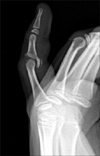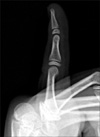Abstract
A 12-year old boy sustained a volarly displaced fracture of the middle phalanx after sustaining a hyperextension injury to the fifth finger. The alignment of the proximal interphalangeal (PIP) joint was maintained and the articular surface of the displaced epiphysis faced the proximal phalangeal head. This is different from case reported elsewhere, which described volarly displaced epiphyseal fractures during the reduction of a volar PIP dislocation. This means that the pathomechanism in the present case is different from the previously reported cases. The closed reduction was successful and the hand function of the patient was satisfactory at the 6 month follow-up.
Figures and Tables
Fig. 1
Lateral X-ray of the fifth finger. The proximal epiphysis of the middle phalanx was located in the volar side of the PIP joint. However, the joint alignment was not disturbed.

Fig. 3
The patient had a full range of motion of the fifth finger and no limitation of the left hand.

Fig. 4
The injured epiphysis healed and appeared normal on the radiographs at 3 months later after the closed reduction.

Fig. 5
The injury mechanism of other volarly displaced cases. (A) The dorsal side of the epiphysis was checked by the proximal phalangeal head during a reduction without adequate longitudinal traction. The arrow indicates the direction of force and the arrowhead indicates the volar plate. (B) An articular surface of the fractured epiphysis faced the soft tissue and the PIP joint was partially dislocated volarly.

Fig. 6
The injury mechanism of the present case (A) Hyperextension force acted on the epiphyseal plate of the middle phalangeal base. (B) The anterior epiphysis attached to the collateral ligament and the volar plate separated from the metaphysic as a result of a shearing force (C) The epiphyseal fragment was rotated 90° and moved to the volar surface of the PIP joint. The central slip was attached to the dorsal fragment of the middle phalanx. An articular surface of the fractured epiphysis faced the proximal phalangeal head and the alignment of the PIP joint was not disturbed.

References
1. Baugher WH, McCue FC 3rd. Anterior fracture-dislocation of the proximal interphalangeal joint. A case report. J Bone Joint Surg Am. 1979. 61:779–778.

2. Hashizume H, Nishida K, Mizumoto D, Takagoshi H, Inoue I. Dorsally displaced epiphyseal fracture of the phalangeal base. J Hand Surg Br. 1996. 21:136–138.

3. Jones NF, Jupiter JB. Irreducible dislocation of the proximal interphalangeal joint associated with an epiphyseal fracture of the middle phalanx. J Hand Surg Am. 1985. 10:261–264.
4. Keene JS, Engber WD, Stromberg WB Jr. An irreducible phalangeal epiphyseal fracture-dislocation. A case report. Clin Orthop Relat Res. 1984. 186:212–215.




 PDF
PDF ePub
ePub Citation
Citation Print
Print



 XML Download
XML Download